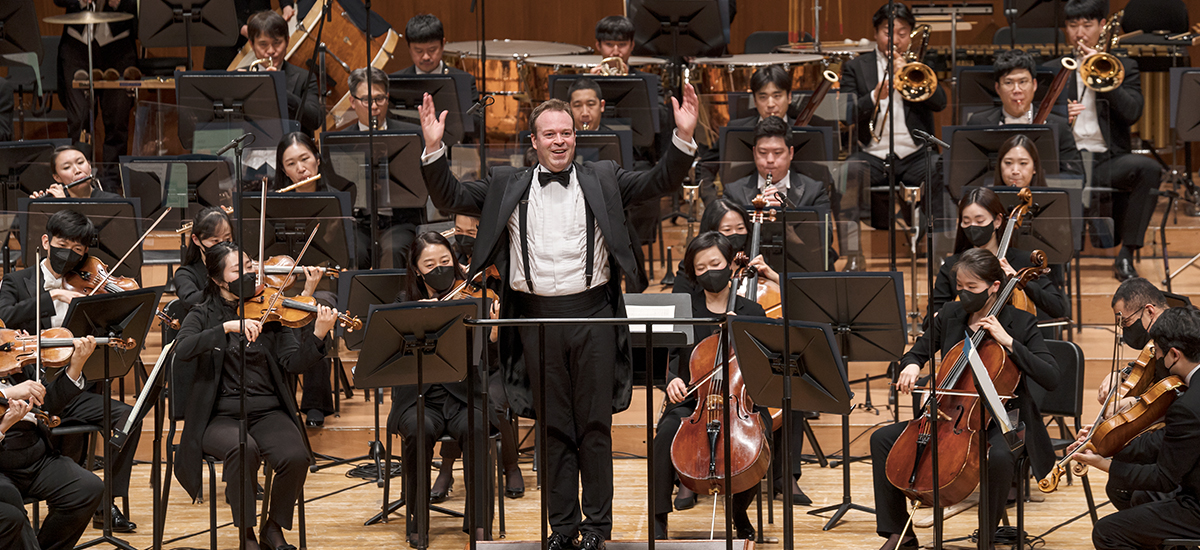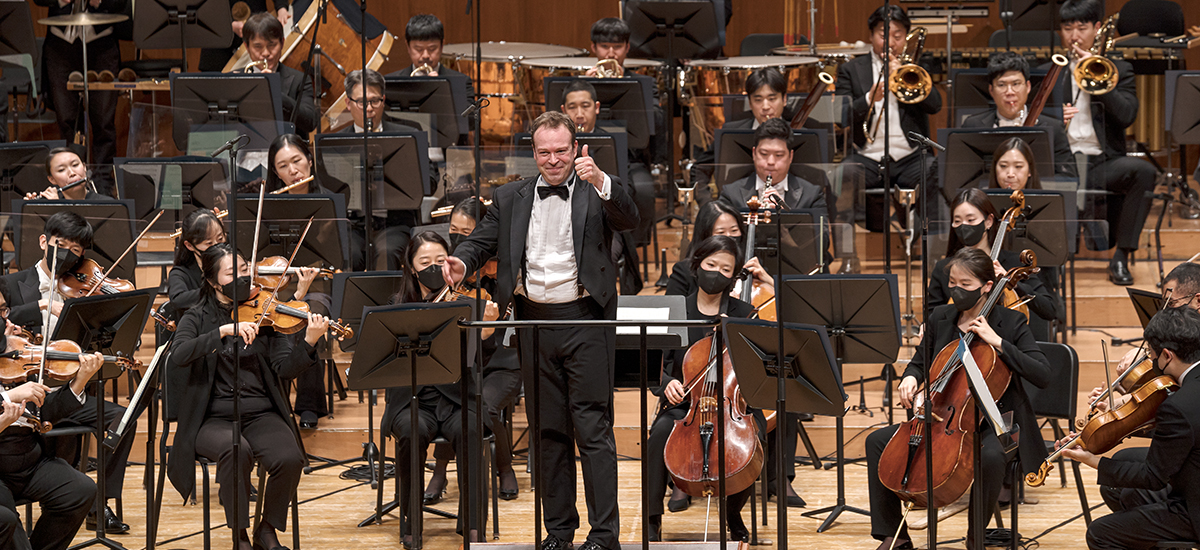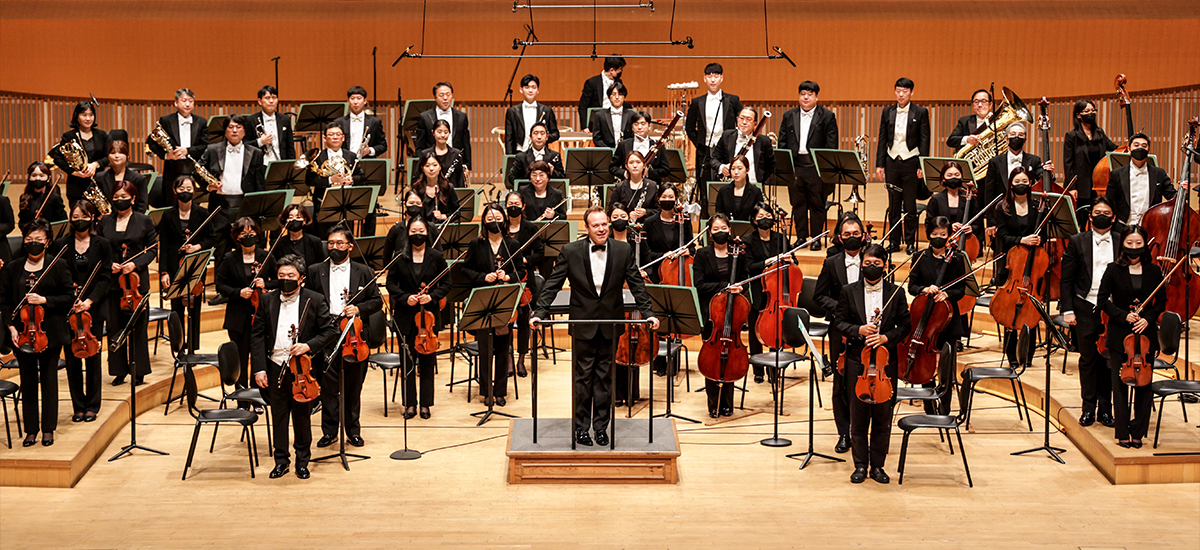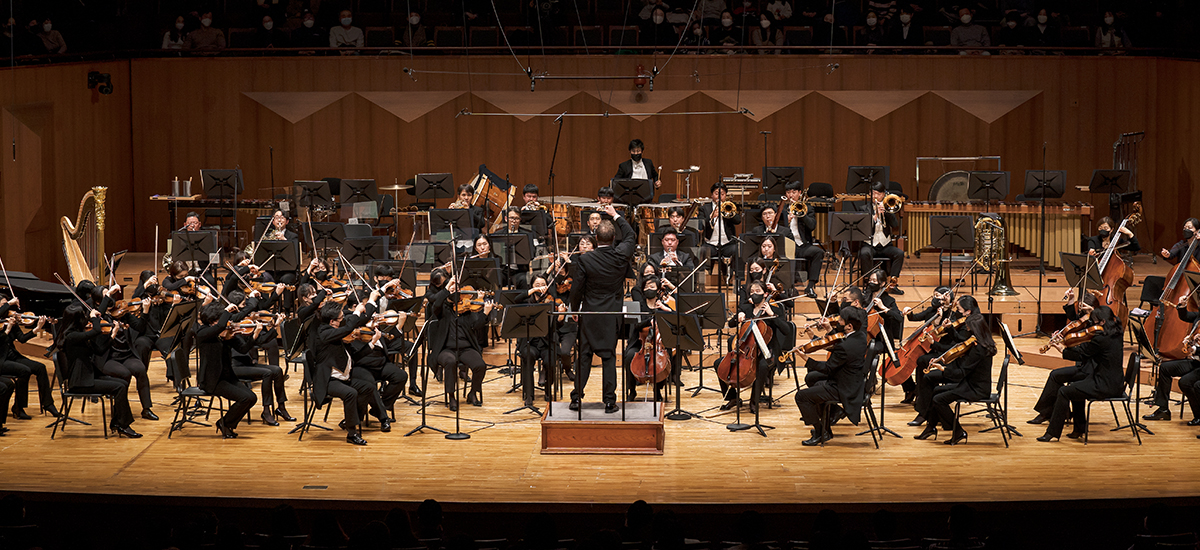Introduction
" The Korean National Symphony Orchestra
marks a new chapter in the history of Korean symphony "

Hong Yeon-taek, who served as the 2nd music director of the National Symphony Orchestra of Korea, emphasized the necessity of a civic orchestra, and led the ensemble with a passion. With his dedication and hard work, the orchestra performed a variety of repertoire encompassing Baroque music to 20th century’s orchestral music with a large ensemble, building its musical prowess. All the while, it was selected as a leading paragon of civic orchestra, which attracted active corporate sponsorship and established a membership system. From 2001, the orchestra was designated as an art group under the Ministry of Culture, Sports and Tourism, conducting a wide rage of activities including orchestral music, ballet, and opera. Revamped as the Korean National Symphony Orchestra (KNSO) in 2022, it is excelling in its role as a national arts organization that actively adapts to the rapidly changing entertainment arts trends amid the new Korean Wave.
Leading orchestra that expands the cultural and arts base
The KNSO strives to expand the base of classical music by crossing the boundaries of arts from authentic classical music to movies, games, and online performances through more than 100 performances a year. Meanwhile, it is actively making efforts to resolve the cultural imbalance between regions by visiting concert halls and cultural sites nationwide. In addition, in line with the rapidly changing media environment, KNSO became the first Korean orchestra to enter the online media service (OTT service), leading a new culture of appreciating music, while also offering the underprivileged, who cannot easily visit a concert hall, an opportunity to enjoy quality cultural contents.
To achieve a sustainable classical music culture
To this end, KNSO is actively seeking out talented musicians in the three key elements of an orchestra – “performer, composer, and conductor.”
KNSO’s various fostering programs, namely the KNSO International Academy that nurtures orchestra performers, the KNSO Composers’ Atelier that provides rising composers with various opportunities, and the KNSO International Conducting Competition and KNSO Conductor Workshop to discover next-generation conductors, are getting a rave reception from young musicians. The musicians who went through the above programs are growing into talented musicians that will lead Korean classical music into the future.
History
-
2022
- January 15thDavid Reiland inaugurated as 7th Artistic Director
- March 2ndName changed to Korean National Symphony Orchestra,
Assistant Conductor Elias Peter Brown,
Composer-in-Residence Yieeun Chun appointed.
-
2021
- January 22ndComposers’ Atelier launched
- May 3rd1st KSO International Orchestra Academy
- November 10th~14th1st KSO International Conducting Competition
-
2020
- November 30thFirst Korean orchestra to enter the OTT market
-
2018
- January 13thInauguration of 6th Artistic Director Chiyong Chung
-
2017
- Bruckner Symphonies Full-length Album (Decca Records)
- received Record of the Year Award
-
2014
- January 26thInauguration of 5th Artistic Director Hunjoung Lim
Hunjoung Lim Composer-in-Residence system Introduced
(Composer-in-Residence Texu Kim invited)
- January 26thInauguration of 5th Artistic Director Hunjoung Lim
-
2011
- January 27thnauguration of 4th Artistic Director Heechuhn Choi
-
2007
- December 1stInauguration of 3rd Music Director Eunseong Park
-
2005
- January 25thInauguration of 2nd Music Director Min Kim
-
1990
- Affiliated Gifted Education Center established
-
1989
- July 20~30th1st Yongpyeong Music Camp Festival
- December 2nd1st 5,000-Voice Chorus Concert for National Unity
-
1987
- August 3rdWater Disaster Relief Fundraising Concert for victims of typhoon Thelma
-
1985
- March 30thConcert for Foundation of Korean Symphony Orchestra and inauguration of 1st Music Director Yeontaek Hong
Vision and Strategy
Objective
To establish a new value and strategic system

Strategic Direction and Tasks
Strengthening orchestra aptitude/competency
- Strengthening artistry and diversity
- Expanding artistic programs
- Enhancing the diversity of music and art activities
Repository of sustainable music ecosystem
- Discovering talented musicians and audience
- Discovering future talented musicians and laying the foundation for nurturing them
- Strategic promotion of audience segmentation marketing
Disseminating the right to enjoy culture and arts in regions
- Resolving the cultural imbalance between regions
- Expanding communication and sympathy with local audiences
Establishing a healthy organization culture
- Building a communicative and cooperative organizational culture
- Expansion of human resources for employment
CI

MOTIVE : PICK UP THE IDEA

CONCEPT
The CI of KNSO was designed by combining straight and curved lines to illustrate the acronym as “KNSO” referring to the Korean National Symphony Orchestra.
The first image symbolizes the musical notes that flow rhythmically with different heights.
This represents the will and resolution of KNSO that will always prioritize “good music” in terms of its value, objective, and vision.
The “K” represents the stage and auditorium. The beautiful sound from the stage echoes throughout the auditorium.
The “N” refers to the KNSO members. The image resembles the shape of notes’ hooked stem from eighth to 64th, and each of them creates a different speed, sound, and tone.
The “S” represents the audience, who experiences a good stage and music with their bright eyes and clear ears, has a smile on their lips.
The “O” symbolizes a life. Relishing in the memorable spectacle of the stage, akin to the lights on a stage, we return to our own life.
The Korean National Symphony Orchestra aspires that many people will lead a more enriched and brighter life through our good music and good performances.
Korean-English mixed version


Korean version

English version

Minimum regulations
When using logotypes, be sure to use Adobe Illustrator files to avoid any changes. When applying them, be sure to comply with regulations and principles to prevent image damage due to distortion, deformation, misuse, etc.
The minimum space regulation specifies the minimum size of each separate space to secure individual images’ independence, so no element can enter within this size.



